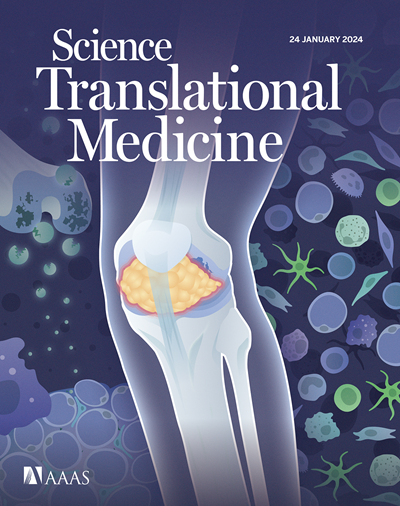Targeting GOLPH3L improves glioblastoma radiotherapy by regulating STING-NLRP3–mediated tumor immune microenvironment reprogramming
IF 15.8
1区 医学
Q1 CELL BIOLOGY
引用次数: 0
Abstract
Radiotherapy (RT) has been the standard-of-care treatment for patients with glioblastoma (GBM); however, the clinical effectiveness is hindered by therapeutic resistance. Here, we demonstrated that the tumor immune microenvironment (TIME) exhibited immunosuppressive properties and high expression of Golgi phosphoprotein 3 like (GOLPH3L) in RT-resistant GBM. Our study showed that GOLPH3L interacted with stimulator of interferon genes (STING) at the aspartic acid residue 184 in Golgi after RT, leading to coat protein complex II–mediated retrograde transport of STING from Golgi to endoplasmic reticulum. This suppressed the STING–NOD-like receptor thermal protein domain associated protein 3 (NLRP3)–mediated pyroptosis, resulting in suppressive TIME, driving GBM resistance to RT. Genetic GOLPH3L ablation in RT-resistant GBM cells augmented antitumor immunity and overcame tumor resistance to RT. Moreover, we have identified a small molecular inhibitor of GOLPH3L, vitamin B5 calcium (VB5), which improved the therapeutic efficacy of RT and immune checkpoint blockade by inducing a robust antitumor immune response in mouse models. Clinically, patients with GBM treated with VB5 exhibited improved responses to RT. Thus, reprogramming the TIME by targeting GOLPH3L may offer a potential opportunity to improve RT in GBM.靶向GOLPH3L通过调节sting - nlrp3介导的肿瘤免疫微环境重编程改善胶质母细胞瘤放疗
放疗(RT)一直是胶质母细胞瘤(GBM)患者的标准治疗;然而,临床效果受到治疗耐药性的阻碍。在这里,我们证明了肿瘤免疫微环境(TIME)在抗rt的GBM中表现出免疫抑制特性和高尔基磷酸化蛋白3样(GOLPH3L)的高表达。我们的研究表明,在RT后,GOLPH3L与高尔基体中天冬氨酸残基184处的干扰素刺激因子(STING)相互作用,导致衣壳蛋白复合物ii介导STING从高尔基体向内质网逆行转运。这抑制了sting - nod样受体热蛋白结构域相关蛋白3 (NLRP3)介导的热凋亡,导致抑制时间,驱动GBM对rt的抗性。基因GOLPH3L消融在rt抗性GBM细胞中增强了抗肿瘤免疫,克服了肿瘤对rt的抗性。此外,我们已经鉴定出GOLPH3L的小分子抑制剂,维生素B5钙(VB5)。通过在小鼠模型中诱导强大的抗肿瘤免疫反应,提高RT和免疫检查点阻断的治疗效果。在临床上,用VB5治疗的GBM患者表现出对RT的改善反应。因此,通过靶向GOLPH3L重新编程时间可能为改善GBM的RT提供了潜在的机会。
本文章由计算机程序翻译,如有差异,请以英文原文为准。
求助全文
约1分钟内获得全文
求助全文
来源期刊

Science Translational Medicine
CELL BIOLOGY-MEDICINE, RESEARCH & EXPERIMENTAL
CiteScore
26.70
自引率
1.20%
发文量
309
审稿时长
1.7 months
期刊介绍:
Science Translational Medicine is an online journal that focuses on publishing research at the intersection of science, engineering, and medicine. The goal of the journal is to promote human health by providing a platform for researchers from various disciplines to communicate their latest advancements in biomedical, translational, and clinical research.
The journal aims to address the slow translation of scientific knowledge into effective treatments and health measures. It publishes articles that fill the knowledge gaps between preclinical research and medical applications, with a focus on accelerating the translation of knowledge into new ways of preventing, diagnosing, and treating human diseases.
The scope of Science Translational Medicine includes various areas such as cardiovascular disease, immunology/vaccines, metabolism/diabetes/obesity, neuroscience/neurology/psychiatry, cancer, infectious diseases, policy, behavior, bioengineering, chemical genomics/drug discovery, imaging, applied physical sciences, medical nanotechnology, drug delivery, biomarkers, gene therapy/regenerative medicine, toxicology and pharmacokinetics, data mining, cell culture, animal and human studies, medical informatics, and other interdisciplinary approaches to medicine.
The target audience of the journal includes researchers and management in academia, government, and the biotechnology and pharmaceutical industries. It is also relevant to physician scientists, regulators, policy makers, investors, business developers, and funding agencies.
 求助内容:
求助内容: 应助结果提醒方式:
应助结果提醒方式:


